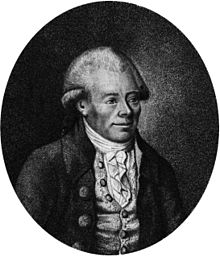
Back Georg Christoph Lichtenberg ALS جورج كريستوف ليشتنبرغ Arabic جورج كريستوف ليشتنبرج ARZ Georq Kristof Lixtenberq Azerbaijani جرج کریستف لیختنبرق AZB Георг Кристоф Лихтенберг Bulgarian Georg Christoph Lichtenberg Catalan Georg Christoph Lichtenberg Czech Georg Christoph Lichtenberg Danish Georg Christoph Lichtenberg German
Georg Christoph Lichtenberg | |
|---|---|
 Georg Christoph Lichtenberg | |
| Born | 1 July 1742 |
| Died | 24 February 1799 (aged 56) |
| Nationality | German |
| Alma mater | University of Göttingen (1763–67)[1] |
| Scientific career | |
| Fields | Scientist, satirist and aphorist |
| Doctoral advisor | Abraham Gotthelf Kästner |
| Doctoral students | Heinrich Wilhelm Brandes Johann Tobias Mayer Ernst Chladni |
Georg Christoph Lichtenberg (1 July 1742 – 24 February 1799) was a German physicist, satirist, and Anglophile. As a scientist, he was the first to hold a professorship explicitly dedicated to experimental physics in Germany. He is remembered for his posthumously published notebooks, which he himself called Sudelbücher, a description modelled on the English bookkeeping term "waste books" or "scrapbooks",[2] and for his discovery of tree-like electrical discharge patterns now called Lichtenberg figures.
- ^ Øksenholt (1963), ch. 1.
- ^ Lichtenberg explained the purpose of his "scrapbook" in his notebook E: Die Kaufleute haben ihr Waste book (Sudelbuch, Klitterbuch glaube ich im deutschen), darin tragen sie von Tag zu Tag alles ein was sie verkaufen und kaufen, alles durch einander ohne Ordnung, aus diesem wird es in das Journal getragen, wo alles mehr systematisch steht ... Dieses verdient von den Gelehrten nachgeahmt zu werden. Erst ein Buch worin ich alles einschreibe, so wie ich es sehe oder wie es mir meine Gedancken eingeben, alsdann kan dieses wieder in ein anderes getragen werden, wo die Materien mehr abgesondert und geordnet sind. "Tradesmen have their 'scrapbook' (scrawl-book, composition book I think in German), in which they enter from day to day everything they buy and sell, everything all mixed up without any order to it, from there it is transferred to the day-book, where everything appears in more systematic fashion ... This deserves to be imitated by scholars. First a book where I write down everything as I see it or as my thoughts put it before me, later this can be transcribed into another, where the materials are more distinguished and ordered."